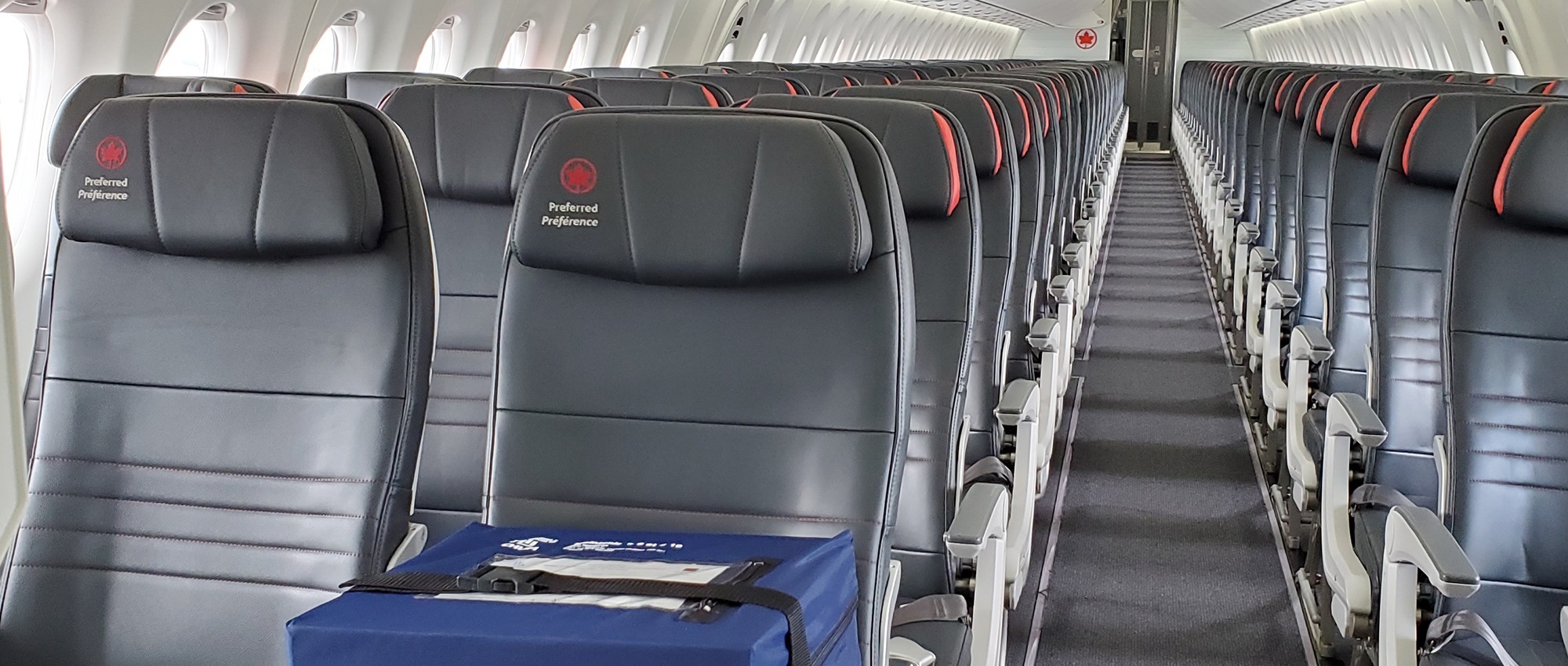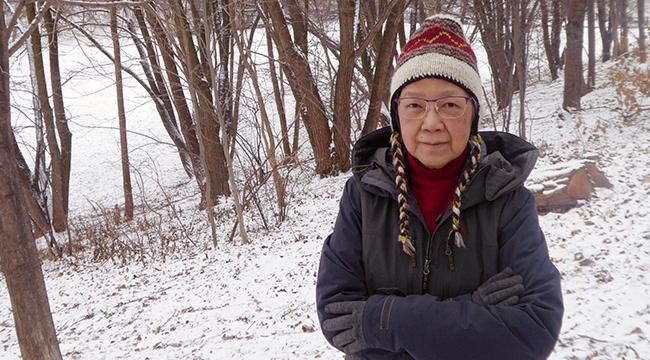Collaboration with Air Canada to ship kidneys takes flight during COVID-19
National air carrier has helped to facilitate kidney transplants from living donors that wouldn't have happened otherwise
While Air Canada has certainly been flying fewer people on life-changing trips since the start of the COVID-19 pandemic, the national air carrier has been integral this past year in helping Canadian Blood Services to transport lifesaving donated organs across the country.
Through its Kidney Paired Donation (KPD) program, Canadian Blood Services works with provincial living kidney donation and kidney transplant programs to match transplant candidates with donors.
Prior to the pandemic, matched kidney donors would have travelled to the transplant centre where the recipient was scheduled to have their transplant surgery. If a living donor in Toronto was matched with a patient in Vancouver, for example, that donor would have flown across the country to have surgery to donate their kidney.
When the pandemic was declared by the World Health Organization, however, transplant programs across the country suddenly had to put this process on pause.
In May 2020, the clinical committees that advise Canadian Blood Services on living organ donation and transplantation activities in Canada recommended that matched donors no longer be required to travel using public transportation methods such as planes or trains to get to the recipient’s transplant centre.
Instead, to minimize the chance of exposure to the coronavirus, the committees recommended that donors who could not travel to the recipient’s transplant centre using private transportation should have their kidney removed at their own local transplant centre and shipped to the recipient.
“With COVID-19, the number one priority of the KPD program continues to be donor and recipient safety,” said Sarah Parfeniuk, program manager for living organ donation and transplantation at Canadian Blood Services. What is kidney paired donation?
Canadian Blood Services’ role in organ and tissue donation and transplantation
Pivoting to a new standard practice of transporting kidneys instead of donors, however, posed some challenges for the KPD program. In the past, said Parfeniuk, kidneys from living donors have only been shipped in exceptional circumstances, usually on direct Air Canada flights.
“We needed support from somewhere — and quickly — to ensure that we could continue to make transplants happen, even if donors could no longer travel,” she said.
“Knowing that Air Canada had previously shipped solid organs for some transplants, our senior leadership team reached out to see if they could possibly provide some guidance.”

An Air Canada pilot sits in the flight deck of a plane in March 2021, ready to take off from the Montréal-Trudeau International Airport.
Not only did Air Canada agree to collaborate with Canadian Blood Services to review their standard operating procedures for the transportation of human organs, they offered to begin routinely shipping kidneys from living donors, free of charge.
With Air Canada’s support, the KPD program has been able to successfully ship 14 donated kidneys to patients in need across Canada since the program restarted in June 2020. Seven have been flown through Air Canada, with five additional shipments scheduled for March 2021.
“These are transplants that simply would not have taken place if it wasn’t for Air Canada,” said Parfeniuk.
Since June 2020, Air Canada and Canadian Blood Services have also been working closely to develop a comprehensive outline of the communication responsibilities between transplant programs and Air Canada throughout the kidney shipment process.
“The hope is that this will give transplant coordinators confidence when they are shipping a kidney, knowing that each step has been laid out,” said Parfeniuk.
The guide outlines, for example, that transplant coordinators will receive real-time updates from the airline when a flight with a shipped organ has taken off, so that they can then contact the hospital receiving the kidney to let them know the organ is on its way.
Time is of the essence in organ transplantation, and kidneys from living donors have been shown to perform best when transplanted within approximately 16 hours of removal from the donor. This makes it critical for transplant coordinators to be able to closely track the organ during its flight and ensure that it gets where it needs to go, on time.
Detailed procedures have also been developed so that transplant coordinators and the airline know exactly what to do in the case of any potential flight changes, diversions, delays or disruptions.

A medical escort carries a donated kidney from the Centre Hospitalier de l'Université de Montréal (CHUM) onto an Air Canada flight in March 2021.
For Air Canada’s part, supporting Canadian Blood Services and the national transplantation system during these unprecedented times has served as an important opportunity for the airline to help ensure that essential services like kidney transport and transplantation continue to be available and accessible for Canadians in need during the pandemic.
“COVID-19 has changed many of the ways that we do business. Working together with Canadian Blood Services to transport kidneys from a donor’s origin point to the recipient’s destination is an excellent illustration of our employees recognizing that despite the many challenges that the pandemic presents, the need to transport essential shipments remains – and that there is always a solution,” said Dr. Jim Chung, chief medical officer at Air Canada.
“This is a clear example of why we need a robust and healthy aviation sector,” he added. “We transport about three unaccompanied emergency live organs in the cabin or flight deck a week, in addition to thousands of non-emergency live organs as cargo each year.”
Change could be long-lasting and may eliminate travel for future donors
The success of the Air Canada collaboration has motivated Canadian Blood Services to look at whether the new processes should become permanent. The KPD program is currently collecting outcome data on the kidneys that have been transported through its partnership with Air Canada. It intends to present this data to its advisory committees, in the hope of making the shipment of kidneys the standard for a post-COVID-19 world.
“We’re trying to collect as much data as possible to show that these shipped kidneys do just as well as if the donor surgery had happened in the operating room right next to the recipient,” said Parfeniuk.
Shipping kidneys instead of requiring people to travel certainly has some clear benefits for donors.
“I think allowing people to donate in their own community and at their own transplant centre as the new standard procedure will be a game-changer for living organ donation in Canada,” said Ian Goodall-George, who has donated one of his kidneys.
About eight years ago, Goodall-George was donating platelets at a Canadian Blood Services donor centre in Winnipeg, Man. when he happened to pick up a brochure about living organ donation. As someone who was always looking for ways to “give back” to his community, he quickly registered to become a non-directed anonymous kidney donor. Before he knew it, he was matched to a patient in Toronto, Ont.
Who can be a living organ donor?
Goodall-George soon learned, however, that in order to donate his kidney, he would need to fly from Winnipeg to Toronto for surgery. And while the organ donation surgery itself was ultimately “extremely smooth and easy,” he said, the travel presented challenges.
First, a snowstorm forced the plane on which Goodall-George and his wife were travelling to circle the airport for hours until it was safe to land. Then after the surgery, his initial recovery took a bit longer than expected, so they had to pay for a hotel in Toronto for several extra nights. Typically, donors pay for their travel, accommodation and related expenses out of pocket, and seek reimbursement through their province’s Program for Reimbursing Expenses of Living Donor (PRELOD). Reimbursement is not immediate, however, and there are maximums set for each category.
Finally, the eventual flight home to Winnipeg on a packed plane, just days after surgery, was “uncomfortable, to say the least,” said Goodall-George.
“If I had been able to stay in Winnipeg and still donate my kidney, there would have been a great deal more support for me,” he said. “My wife could have dropped me off at the hospital, we wouldn’t have had to arrange childcare for the week we were both away, and I think the stress on everyone in my family would have been reduced.”
Despite the challenges, Goodall-George says he will be “forever grateful” for the opportunity to donate his kidney and save a life. But making it easier for donors could also be good news for the many patients in need of a transplant.
“I think that by removing the burden of donors having to fly to donate their kidney, it will lead to people becoming a lot more willing to step forward to become donors,” he said.



